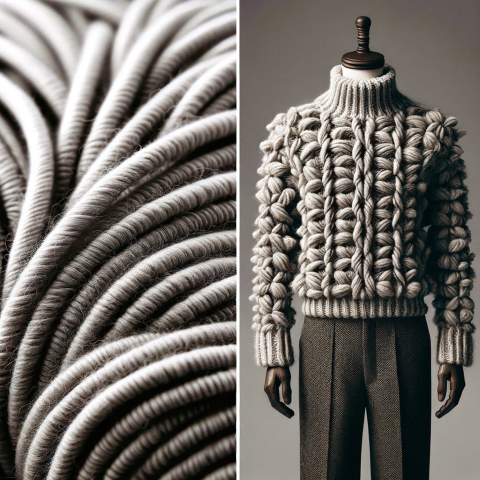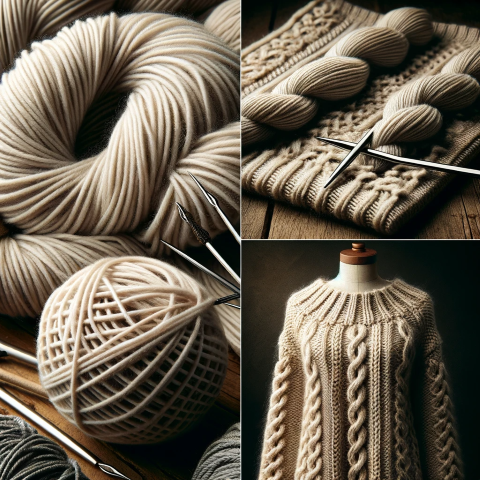Last Updated on: 03-Mar-2024 (4 months, 24 days ago)
Share on Facebook • Share on Twitter
One of the most common methods of creating textured yarn is by twisting. In this process, the yarn is twisted in a way that creates irregularities in the surface of the yarn. This can be done using a variety of different techniques, such as twisting the yarn at different intervals or using different types of twist. The result is a yarn with a rough, uneven surface that has a more interesting texture than a smooth, uniform yarn.
Another way to create textured yarn is by crimping. In this process, the yarn is put through a machine that compresses and stretches it in a way that creates waves or curls in the fibers. This can be done with synthetic or natural fibers, and can create a range of different textures depending on the degree of crimping.
Heat setting is another common method of creating textured yarn. In this process, the yarn is exposed to heat in order to change its physical properties. This can be done by passing the yarn through a heated chamber, or by using a special type of yarn that is designed to respond to heat. The result is a yarn with a more rigid texture that holds its shape better.
Textured yarn can be used for a variety of different purposes in textile production. For example, it can be used to create more interesting and complex patterns in woven or knitted fabrics. It can also be used to add more depth and dimension to fabrics that would otherwise be flat and uninteresting.
One of the advantages of using textured yarn is that it can be used to create a wide range of different effects. For example, a yarn with a highly twisted surface might be used to create a fabric with a more rough, rustic feel, while a yarn with a more uniform crimp might be used to create a fabric with a more subtle, elegant texture.
Another advantage of textured yarn is that it can help to improve the performance of certain types of fabrics. For example, a yarn with a crimped surface might be used to create a fabric with better insulation properties, as the crimped fibers help to trap air and retain heat. Similarly, a yarn with a heat-set surface might be used to create a fabric that is more resistant to wrinkling or stretching.
Textured yarn can be made from a variety of different fibers, including both natural and synthetic materials. Common fibers used for textured yarns include wool, cotton, silk, nylon, and polyester. Different fibers will have different properties, such as strength, elasticity, or absorbency, which can affect the performance of the final product.
In addition to the different methods of creating textured yarn, there are also different types of textured yarn. Some textured yarns have a consistent texture throughout the length of the yarn, while others have sections of textured yarn interspersed with sections of smoother yarn. Some textured yarns are also designed to change texture when exposed to different temperatures or other environmental factors.
Overall, textured yarn is a versatile and useful material for textile production. It can be used to create a wide range of different textures and effects, and can be made from a variety of different fibers. Whether used for fashion, home decor, or industrial applications, textured yarn can help to add interest, dimension, and functionality to a variety of different fabrics and products.
A yarn that has been so processed as to introduce durable crimps (q.v.), coils, loops or other fine distortions along the length of the fibres or filaments.
NOTE:
a) The main texturing processes usually applied to continuous-filament yarns made from or containing thermoplastic fibres, are as follows:
1. The yarn is highly twisted, heat-set and untwisted, either as a continuous process (false twisting) or as a three-stage process.
2. The yarn is passed through a heated "stuffer box" (stuffer box crimping).
3. The heated yarn is passed over a knife edge (edge crimping).
4. The heated yarn is passed between a pair of geared wheels or some similar device (gear crimping).
5. The yarn is knitted into a fabric, heat-set and unravelled (knit-deknit).
6. Loops are formed in individual filaments by over-feeding into a turbulent airstream (air-textured).
7. Bicomponent Fibres (q.v.) are differentially shrunk.
b) Processes (1) and (3) above produce yarns of a generally high stretch character. This stretch character is frequently reduced by reheating the yarn in a state where it is only partly relaxed from the fully extended condition, thus producing a yarn with the bulkiness little reduced but with a much reduced retractive power.
c) Fabrics that contain textured yarns have increased bulk, opacity, and moisture absorbency and improved thermal insulation properties with a warmer handle (q.v.); some textured yarns also confer extensible or "stretch" properties on fabrics made from them.
Some more terms:
Alencon lace
A needlepoint lace on a fine net background. Characterized by a heavy thread (cordonnet) outlining the design. Although usually machine made, there are instances where the cordonnet is inserted/done...
Read about Alencon laceKnitted
Knitting is a craft by which thread or yarn may be turned into cloth. Similar to crochet, knitting consists of loops called stitches pulled through each other. Knitting differs from crochet in that...
Read about KnittedNovelty Yarn
A yarn that is intentionally produced to have a special or unique effect. These effects can be produced by twisting together uneven single yarns, by using yarns that contain irregularities, or by...
Read about Novelty YarnPolished Cotton
A plain weave cotton cloth characterized by a sheen ranging from dull to bright. polish can be achieved either through the weave or the addition of a resin finish. Can be a solid color, usually piece...
Read about Polished CottonDrop Needle
Drop Needle is a technique commonly used in textile manufacturing that involves creating unique patterns and textures in fabrics. It is a type of knitting technique that produces a distinctive...
Read about Drop NeedleBilliard Cloth
The highest grade of material made from the best of stock ? Saxony, Silesia, or Australia merino wool. Two-up and one-down twill weave is used. Set in the reed at 144 inches and finished at about 72...
Read about Billiard ClothThe Drawing Process: A Fundamental Textile Technique
Drawing is a process in the textile industry that involves the reduction of the thickness of fibers through the use of machines. It is also known as drafting and is commonly used in the spinning of...
Read about DrawingMartindale Test
Fabric is mounted flat and rubbed in a figure eight-like motion using a piece of worsted wool cloth as the abradant. The number of cycles endured before the fabric shows an objectionable change in...
Read about Martindale TestAdd a definition
- The term you want to define
- Its definition in 500 words or less
- Attach an image if necessary.
- Optionally, tell us about yourself in 200 words or less!
Companies for Textured Yarn:
- Company name
- Company address
- Attach a logo, if necessary.
- Optionally, tell us about yourself in 200 words or less!

 South Korea is a major exporter of garments to the United States and European markets.
South Korea is a major exporter of garments to the United States and European markets.

